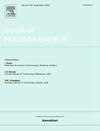能量塌缩对中子有效寿命的影响
IF 2.3
3区 工程技术
Q1 NUCLEAR SCIENCE & TECHNOLOGY
引用次数: 0
摘要
有效平均提示中子生成时间(或有效寿命)是核反应堆时变分析点动力学模型中引入的一个积分参数。尽管这种模型需要对中子动力学过程进行极大的简化,但有效中子寿命的值可以提供关于倍增系统的物理特性及其对扰动的时间响应的直接和有用的信息。此外,点动力学仍然用于控制和瞬态情况的模拟,特别是以相反的方式解释中子实验。根据导出点动力学方程的标准分离-投影数学程序,将有效寿命定义为系统内总瞬时重要性与单位时间内裂变产生的总重要性之比。有效寿命的评估可以用确定性和随机计算工具进行。如果使用不同的物理模型,可以观察到相关的差异。本文特别关注的是所采用的能量结构。在第一部分中,对简化构型进行了一些分析分析,以获得与能量群结构细节有关的对参数计算值的影响的一些物理见解。然后,一些更详细的数值研究允许调查更复杂的配置。该研究包括临界和次临界、源驱动系统。本文章由计算机程序翻译,如有差异,请以英文原文为准。
Impact of energy collapsing on the effective neutron lifetime
The effective mean prompt neutron generation time (or effective lifetime) is an integral parameter that is introduced in the point kinetic model for nuclear reactor time-dependent analysis. Although such a model requires a strong simplification of the neutron kinetic process, the value of the effective neutron lifetime can give an immediate and useful information on the physical characteristics of a multiplying system and on its time response to perturbations. Furthermore, point kinetics is still used for the simulation of control and transient situations and, especially, in an inverse fashion for the interpretation of neutronic experiments. Based on the standard separation-projection mathematical procedure to derive point kinetics equations, the effective lifetime is defined as the ratio between the total instantaneous importance within the system and the total importance generated by fission per unit time. The evaluation of the effective lifetime can be carried out by both deterministic and stochastic computational tools. Relevant differences can be observed if different physical models are used. In this paper the attention is particularly focused on the energy structure employed. In the first part some analytical analyses for simplified configurations are carried out, in order to gain some physical insight on the effects associated with the detail of the energy group structure on the computed value of the parameter. Then, some more detailed numerical studies allow to investigate more complex configurations. The study includes both critical and subcritical, source-driven systems.
求助全文
通过发布文献求助,成功后即可免费获取论文全文。
去求助
来源期刊

Annals of Nuclear Energy
工程技术-核科学技术
CiteScore
4.30
自引率
21.10%
发文量
632
审稿时长
7.3 months
期刊介绍:
Annals of Nuclear Energy provides an international medium for the communication of original research, ideas and developments in all areas of the field of nuclear energy science and technology. Its scope embraces nuclear fuel reserves, fuel cycles and cost, materials, processing, system and component technology (fission only), design and optimization, direct conversion of nuclear energy sources, environmental control, reactor physics, heat transfer and fluid dynamics, structural analysis, fuel management, future developments, nuclear fuel and safety, nuclear aerosol, neutron physics, computer technology (both software and hardware), risk assessment, radioactive waste disposal and reactor thermal hydraulics. Papers submitted to Annals need to demonstrate a clear link to nuclear power generation/nuclear engineering. Papers which deal with pure nuclear physics, pure health physics, imaging, or attenuation and shielding properties of concretes and various geological materials are not within the scope of the journal. Also, papers that deal with policy or economics are not within the scope of the journal.
 求助内容:
求助内容: 应助结果提醒方式:
应助结果提醒方式:


